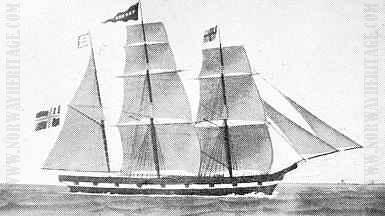It is said about the Tengner that in 1853 she was a bad and old ship. The
emigrants had to wait for two weeks to depart. Two people died during the crossing and
one child was born, the child was called
Tegneria after the ship (Ref: Jacob
Worm-Muller "Den norske Sjøfartshistorie p. 600" - "The Norwegian Maritime History")
A reference to the Tegner was found in the book: "Norway to America" - A History of the Migration by Ingrid Semmingsen translated from Norwegian by Einar Haugen:
"To judge by letters and other accounts the passage was often
remarkably easy. Once seasickness had been mastered, and when the winds
were not to stiff, spirits were gay and lively. Experienced skippers
tried to provide the passengers by helping them keep clean, sweeping and
scrubbing the decks and airing the clothes, as well as providing
exercise and entertainment. There were races, wrestling, and dancing on
deck. The captain on the Tegner encouraged dancing when the ship was
becalmed. If they danced, they would be sure to get wind, he claimed.
So the fiddles were brought out, and the passengers danced waltzes,
polkas, and schottisches, as well as the old Norwegian country dances,
the "spring dance" and the "halling." "(P. 60, Chapter: The Long Journey
Section: On Board)
A JOURNEY TO AMERICA IN THE FIFTIES (on the ship Tegner)
BY CLARA JACOBSON - This paper first appeared in Symra, 10:120-157 (1913), under the title "En Amerika-reise for seksti aar siden." The child who figures in this story was the author's mother, Nicoline Hansen Hegg, who was born in 1844. She married the Reverend Abraham Jacobson in 1865, and died in 1929. Also published in "Norwegian-American Studies, Volume 12" which was published by NAHA in 1941.
The Information was collected by
Luci Baker of
Seattle, her gggrandmother Sigrid VISTE came to America on the Tegner when she was 4 months old,
and her gggrandfather Johan HEGG (aka HANSON) when he was 5 years old. The two
families met during the voyage and traveled together. Luci wanted to find out more
about the ship and the history of the voyage.
 The Tegner, rigged as a bark
The Tegner, rigged as a bark Morgenbladet, 1853 |
 Morgenbladet 1853 |